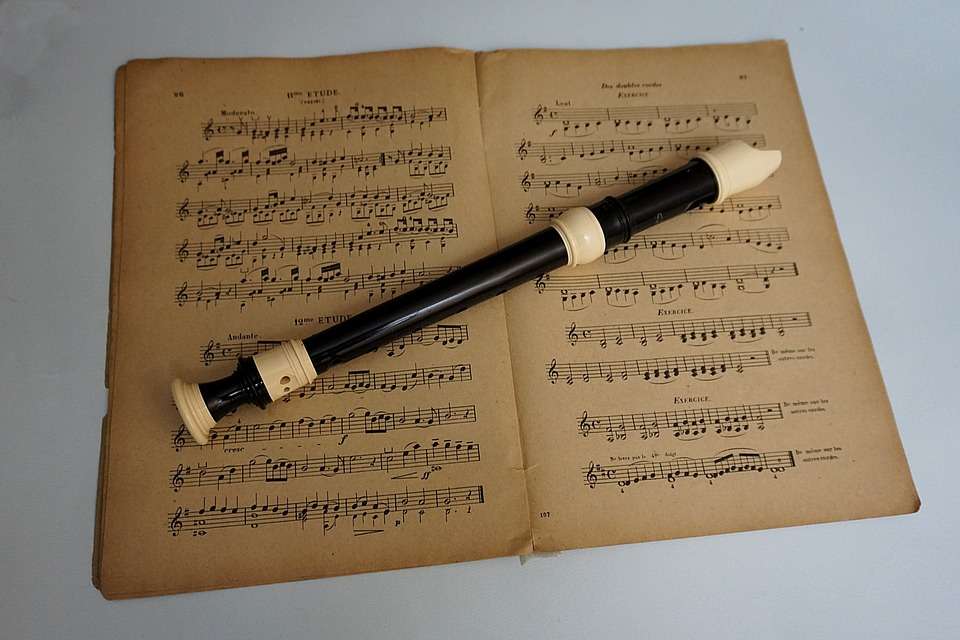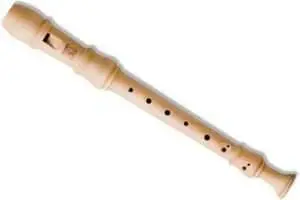
The recorder from scratch. The sound of the flute.
 Searching for sound
Searching for sound
In fact, all the beauty of the recorder lies in its sound. It is the result of the characteristic structure of this instrument, which is able to achieve such a sound. However, whether the obtained sound will be fuller, more noble or average, it depends on the material from which our instrument is made.
For the most part, we have a chance to get a more noble sound with a wooden instrument and it is on these instruments that we will focus more. There are at least several dozen types of wood that are used to build recorders. They are varied genres, which is why we get a different shade of the color of our instrument from each of them. The most popular are, among others: pear, rosewood, boxwood, olive, grenadilla, tulip tree, ebony, maple or plum. Which instrument to choose depends primarily on the individual preferences of the player himself.
A slightly different sound is preferred for solo play and different for team play. Wood types that give a round, elegant and more expressive sound are more suitable for solo playing. On the other hand, for flute ensembles, it is better to use instruments made of wood that allows for a softer sound, which is therefore more subdued in this respect.
Sound possibilities
As it was mentioned in the previous part of our guide, the most popular recorders are the C soprano recorders, which range from c2 to d4. On the other hand, if we want to achieve a lower sound, we can use the alto flute, the range of which is on a scale from f1 to g3. Lower than the alto flute, the tenor flute with the range of notes from c1 to d3 will play, and the bass flute with the range of notes from f to g2 at the lowest. On the other hand, the highest sounding one will be a sopranino flute with a scale of notes from f2 to g4. These are the most popular types of recorders, the size arrangement of which is practically the same as for other wind instruments, e.g. saxophones. Of course, there are other less popular varieties, such as the C tuning bass recorder, or the double bass, sub-bass or sub-sub-bass flute. Thanks to such a wide range of different types of the recorder, we are able to find the use of the instrument in almost every musical genre and key.
Types and systems of fingering
The most popular types of fingering are the German and Baroque systems. It is valid for the majority of school flutes and therefore, before making a purchase, you should know what the differences between the two systems are to make the best choice. The most important difference can be found in the fingering of the F note with a soprano instrument, which at first glance is simpler in the German system than in the Baroque system. In the German system, all three lower holes are opened, while in the Baroque system only the third hole from the bottom is opened, which forces us to cover the two lower holes. Of course, it is really just a matter of a certain technical habit, but we should not be guided by this aspect of facilitation, because this facilitation may bring us discomfort in the long run.
We should look further at more developed grips that allow us to play raised or lowered sounds. And here, with the German system, we may have problems with proper tuning when trying to extract, for example, the F sharp sound, which will require more complicated fingering to achieve pure intonation. For this reason, the vast majority of textbooks are focused on the shoulder system, which in a broader educational context is more accessible to the student.
How to recognize the baroque system visually and how to German
Recipes, no matter what system they are built for, look almost identical. Such a visible difference is that in the Baroque system, the opening of the F sound in the case of the soprano recorder or the B sound in the case of the alto flute is larger than the other openings.
Double holes
The two lower holes in standard recorders allow us to play an elevated note. For a soprano instrument, these will be the notes C / Cis and D / Dis. It is thanks to whether we cover one of the two holes or both holes that we can increase or decrease the sound.
Flute maintenance
And as in the case of a plastic flute, it is enough to clean and rinse it well, in the case of a wooden flute, it needs to be additionally maintained from time to time. In order to protect the instrument from the moisture generated when playing, the wooden flute must be oiled. This oil maintains the full beauty of the sound and reaction. In the absence of such maintenance, our instrument may lose the quality of its sound, and the outlet opening will become undesirable roughness. How often to lubricate our instrument largely depends on what type of wood it is made of and what the manufacturer’s recommendations are.
However, it is assumed that such oiling should be carried out about two or three times a year. Linseed oil is such a natural oil for impregnating wooden instruments.
Delving deeper and deeper into our knowledge of the recorder, we see that a seemingly simple school musical instrument begins to transform into a serious, full-fledged instrument that can not only sound beautiful, but which, above all, must also be properly looked after.





